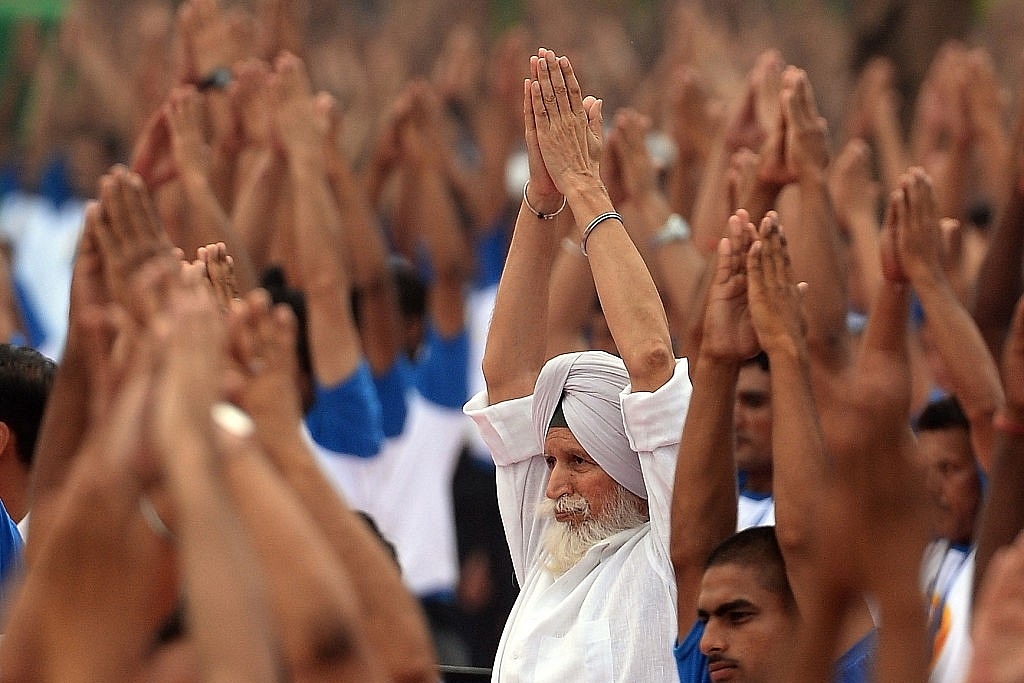Ideas
Yoga Day Celebrations – Taking Indic Thought To The World
- India has constantly used ‘yoga’ in the widest sense of the term – as a way of bringing welfare to humanity. The International Yoga Day celebrations must be seen in this context.

Yoga is for overall welfare of body and mind (Photo: PRAKASH SINGH/AFP/Getty Images)
On 27 September 2014, Prime Minister Narendra Modi, while speaking at the United Nations (UN), demanded that the UN declare an ‘International Day of Yoga’. A couple of months later, on 11 December 2014, the UN General Assembly announced 21 June as the day for celebrating the International Day of Yoga.
In his speech at the UN, while appealing for instating such a day, Prime Minister Modi’s reference to yoga was made in the context of climate change and going back to basics. He said:
Yoga as a way of life to ‘heal the planet’ may appear far-fetched at first glance.
Much criticism had started flowing in from the usual quarters after he gave his speech. For instance, Sohail Hashmi, who is an academic and activist from the Left, had said:
But in his speech, Modi had tried to take yoga from a form of physical exercise to a way of life, a spiritual philosophy. He is not the first to see solutions to the problems of modern times in yogic philosophy and culture.
Indian philosopher, yogi, and guru Sri Aurobindo thought yoga encompassed ‘all life’. He wrote in his published work The Supramental Manifestation and Other Writings:
Even Mahatma Gandhi had elaborated on the importance of the cardinal principles of Yamas and Niyamas in the Yogasutras of Patanjali in forging the tool of Satyagraha and envisioning the upliftment and Sarvodaya, welfare of all, as pointed out by Dr Ajay Shanker Rai, a noted Gandhian scholar. Such strands of thought can be observed across many of our cultural and social habits.
India at the top of Greendex
The National Geographic conducted a transnational survey for over six years from 2008 to 2014 that computed something called the ‘Greendex’ - a measure of the environmental impact of a person’s consumption patterns.
The survey found that India, with a score of 61.4, topped the world rankings. The study said, “Indians’ Greendex score has increased considerably since 2012, and they remain in first place overall. Their Housing score has increased greatly, and their Food score has also increased. Their Transportation score has also seen a modest increase.”
In the crucial area of food consumption, the six-year study revealed the following:
- Indians are among the least frequent consumers of imported foods, and consumption of such foods has decreased since 2009. They are among the highest consumers of self-grown food.
- They are less likely to consume beef or pork than consumers in other countries that were surveyed.
- Indians are among the most frequent consumers of fruits and vegetables.
It is the values of restraint inherent in Indian culture that has led to these eco-friendly food habits. One should note that it is not rigid, dogmatic vegetarianism but the intrinsic culture-based controls in meat consumption of non-vegetarians that makes the system green-friendly. This, in turn, relates to the core yoga values that have shaped the cultural and social life in India, namely moderation in consumption and self-reliance rather than the squandering of external sources.
In other areas of life, too, like indigenous building technologies or water management systems, these core values come into focus. What’s interesting to note is that these values have evolved indigenously over time rather than imposed through scripture or State. Sri Aurobindo and his spiritual collaborator, The Mother’s (born Mirra Alfassa) movement with its roots in ‘Integral Yoga’ and emphasis on futuristic humanity made some of the boldest experiments in blending Indic knowledge systems with the science of ecology.
The ‘Auroville charter’, drafted by The Mother, speaks of ‘taking advantage of all discoveries from without and from within’, in order to ‘boldly spring towards future realisations’. Today, Auroville is at the heart of the largest solar power installation in India. It is one of the foremost hubs in disseminating innovative renewable energy technology. It is this inner-outer connection that Modi spoke about at the UN.
Thus it is neither a coincidence nor rhetoric that Modi associates yogic values with climate change and that the Nationally Determined Contribution (NDC) document of India at Paris, which assures that Indians will use 100 gw of solar power by 2022, begins with a hymn from Yajur Veda: “Unto Heaven be Peace, Unto the Sky and the Earth be Peace, Peace be unto the Water, Unto the Herbs and Trees be Peace.”
So while yoga as a form of physical exercise is the most popular and easy way to introduce yogic values to the world community, the ultimate aim is to make the yogic way of life available to the world at large.
From Patanjali’s Yoga Sutras to Sri Aurobindo’s Integral Yoga, as well as Gandhi’s Anasakti Yoga and Swami Vivekananda’s Karma Yoga, India has constantly used the term ‘Yoga’ in the widest sense of the term - as a way of bringing welfare to humanity. The International Yoga Day celebrations must be seen in this context. Vedic seers declared the mission thus: Krinvanto Vishwam Aryam - to Make the World Noble.
(This article was earlier published here on 21 June 2016)
Introducing ElectionsHQ + 50 Ground Reports Project
The 2024 elections might seem easy to guess, but there are some important questions that shouldn't be missed.
Do freebies still sway voters? Do people prioritise infrastructure when voting? How will Punjab vote?
The answers to these questions provide great insights into where we, as a country, are headed in the years to come.
Swarajya is starting a project with an aim to do 50 solid ground stories and a smart commentary service on WhatsApp, a one-of-a-kind. We'd love your support during this election season.
Click below to contribute.
Latest